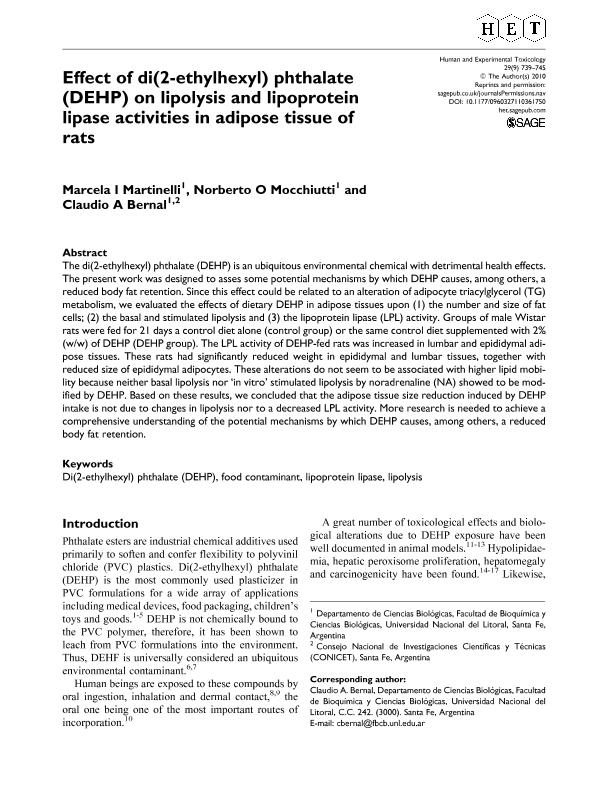Artículo
Effect of di(2-ethylhexyl) phthalate (DEHP) on lipolysis and lipoprotein lipase activities in adipose tissue of rats
Fecha de publicación:
09/2010
Editorial:
Sage Publications Ltd
Revista:
Human and Experimental Toxicoloxy
ISSN:
0960-3271
Idioma:
Inglés
Tipo de recurso:
Artículo publicado
Clasificación temática:
Resumen
The di(2-ethylhexyl) phthalate (DEHP) is an ubiquitous environmental chemical with detrimental health effects. The present work was designed to asses some potential mechanisms by which DEHP causes, among others, a reduced body fat retention. Since this effect could be related to an alteration of adipocyte triacylglycerol (TG) metabolism, we evaluated the effects of dietary DEHP in adipose tissues upon (1) the number and size of fat cells; (2) the basal and stimulated lipolysis and (3) the lipoprotein lipase (LPL) activity. Groups of male Wistar rats were fed for 21 days a control diet alone (control group) or the same control diet supplemented with 2% (w/w) of DEHP (DEHP group). The LPL activity of DEHP-fed rats was increased in lumbar and epididymal adipose tissues. These rats had significantly reduced weight in epididymal and lumbar tissues, together with reduced size of epididymal adipocytes. These alterations do not seem to be associated with higher lipid mobility because neither basal lipolysis nor in vitro stimulated lipolysis by noradrenaline (NA) showed to be modified by DEHP. Based on these results, we concluded that the adipose tissue size reduction induced by DEHP intake is not due to changes in lipolysis nor to a decreased LPL activity. More research is needed to achieve a comprehensive understanding of the potential mechanisms by which DEHP causes, among others, a reduced body fat retention.
Archivos asociados
Licencia
Identificadores
Colecciones
Articulos(CCT - SANTA FE)
Articulos de CTRO.CIENTIFICO TECNOL.CONICET - SANTA FE
Articulos de CTRO.CIENTIFICO TECNOL.CONICET - SANTA FE
Citación
Martinelli, Marcela Inés; Mocchiutti, Norberto Oscar; Bernal, Claudio Adrian; Effect of di(2-ethylhexyl) phthalate (DEHP) on lipolysis and lipoprotein lipase activities in adipose tissue of rats; Sage Publications Ltd; Human and Experimental Toxicoloxy; 29; 9; 9-2010; 739-745
Compartir
Altmétricas




